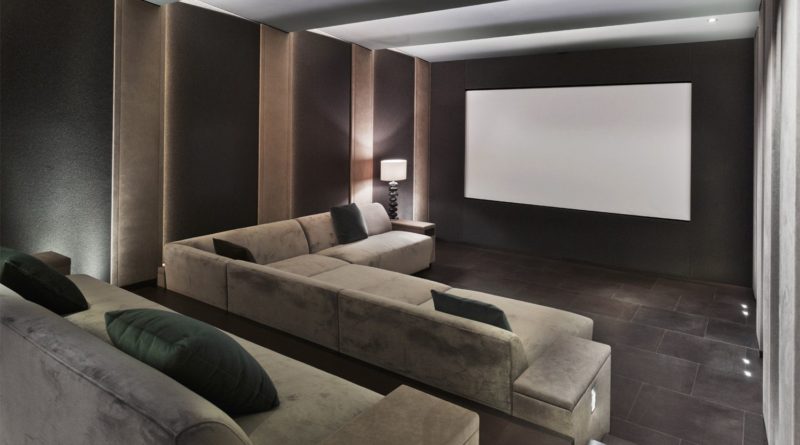SCI-TECH: 15 Tips for Building the Perfect Home Theater Room
:max_bytes(150000):strip_icc():format(webp)/home-theater-room-getty-vostok-57f55aeb3df78c690f118170.jpg)
Vostok / Getty Images
.
.
.
Building a home theater room can often be the true endpoint of home remodeling. Once you have concluded the more utilitarian work of fixing windows and installing floors, it’s time to reach deeper into the bank account and lavish attention on your entertainment needs. After all, who doesn’t need a home movie theater room?
But a home theater room is more than just a sofa and a screen. Certain requirements, like controlling outside light and the ability to cast a large enough picture, should be met in order to call this a proper home movie theater. Requirements apply both to video projectors and screens as well as to large, flat-screen TVs.
-
01of 15
Locate the Home Theater Room in a Dedicated Space
A dedicated home theater room is a room solely dedicated to watching videos on a big screen. This means that little else happens in that home theater except for screening-related activities. And today, screening means far more than it ever did, with streaming services like Amazon Prime, Netflix, and Hulu, BluRay movies, video gaming, and conventional cable TV.
When the home theater shares space with other activities, the cinematic experience is lessened. When the non-dedicated home theater shares open floor plan space with the kitchen, cooking sounds and smells invade. When the theater is the living room, kids run around and light is difficult to control.
Spare bedrooms work fine, but they do need to be long enough so that viewers can maintain a proper distance from the screen. This is especially important with video projectors. At the extreme end, a projector needs roughly a 14-foot throw distance in order to cast a 150-inch diagonal picture, though short-throw projectors are available.
.

.
-
02of 15
Control the Ambient Light
Ambient light means light from sources outside of the theater, such as from other rooms or through windows. With most home remodeling, you’re always trying to add more natural light. Home theaters are spaces where you want to limit ambient light, whether natural outdoor light or light from other rooms. Light-bleed kills video projection images and it even makes flat-screen viewing less than enjoyable. On the video projector side, you will need a projector with a high lumens rating if you have some ambient light that you cannot control. But the best way to deal with ambient light is simply to stop it before it starts, by choosing a space that already has little light, such a basement. If you cannot do this, limit the light with light-blocking curtains and shades.
.

.
-
03of 15
Control the Ambient Sound
Ambient sound is the unwanted sound coming from outside of your home theater. Even if you do manage to find a dedicated space for your home theater, sounds from outside of that space often ruin the viewing experience. Dishwasher, kids in other rooms, kitchen noises, plumbing noises, and sounds from outside the house are just a few examples of ambient sounds that can crash in and destroy your home theater’s audio.
Establishing a dedicated space is the first step to controlling outside noise. But you do need to take it a few steps beyond that:
- Soundproof your room by adding a second layer of drywall or replacing it with a special sound-reducing wallboard like QuietRock.
- Replacing your hollow-core doors with solid doors also goes a long ways toward soundproofing your home cinema.
- If you do have windows in your home theater, put up thicker curtains that both block light and absorb sound.
.
-

.
04of 15
Build a Proper A/V Component Rack
The audio-visual component rack, or A/V rack, is the central point for your source components. Consider the A/V rack to be the central brain that controls all entertainment-related activities in the theater.
Source components such as a BluRay player, cable box, network media streaming box (like Roku), and home theater tuner will operate from here. This should be located near an electric outlet and you should be able to bring in an Internet source wire.
.

.
-
05of 15
Properly Ventilate the A/V Rack
The A/V component rack should be well-ventilated since components create heat and can be damaged if the heat build-up is excessive. Metal A/V racks are available for purchase that are open-air in front and back. You can build your own A/V rack, as well. The rack needs to be sturdy enough to hold the electronics. It also should be open in front, back, and even the sides, if possible. Finally, using metal grid as a platform for the electronic devices will help promote ventilation.
.

.
-
06of 15
Make the Home Theater Look Like a Cinema
What is your vision of a home theater? For some homeowners, it’s the classic movie theater with red velvet walls, sconce lights, tiered seating, and a popcorn maker. For others, it’s a drastically scaled-down version of this. And for another group of people who didn’t grow up going to movie theaters, it might mean something completely different.
Older commercial theaters have sloped floors and contemporary ones have elaborate, steeply tiered seating. Home cinema seat tiering is relatively simple to build with a framework of joists of two-by-six or two-by-eight boards set on edge. Half-inch interior grade plywood forms the top, and carpeting goes on top of the plywood.
.

.
-
07of 15
Plan a Robust, Flexible Lighting System
Cinema light control means the ability to turn lights on and off or to graduate that light within the cinema space. Soffits, rope lights, dimmers, and recessed lights form the backbone of many owner-built home theaters. Soffits are long trays near the ceiling that run around the room’s perimeter and are often inlaid with rope lights. Additionally, small recessed lights may be added to the bottoms of the soffits or in the ceiling to shine downward to form the classic home theater look. Try to keep the majority of these lights behind the viewer to avoid degrading the viewing experience.
.

.
-
08of 15
Limit Reflective Objects
Anything that isn’t the screen itself and which reflects light back at the viewer should be minimized or avoided. This means that your paint should be kept to flatter sheens, preferably matte or flat. Shiny doorknobs, hinges, light fixtures, recessed light trim kits, countertops, and fireplace inserts should all be avoided in the crucial zone between the screen and the viewer. If you do have reflective objects, consider reducing their shininess by spray-painting them with dark-colored matte paint.
.

.
-
09of 15
Plan for Proper Viewing and Seating
No one in the theater should have their view of the screen blocked or be too close or too far away. Tiered seating is a true luxury and one that can only be accomplished in a dedicated cinema space. The problem of blockage is solved by raising rear seats on a platform. Even a modest 6-inch boost can be enough to clear the sight lines.
Distance from the screen is determined by room size in conjunction with the size of the picture you want to display. For flat-screen TVs, your small converted bedroom space might be able to accommodate up to a 55-inch screen before the closest row of viewers begins to feel overwhelmed.
Seating does not need to be specialty home theater seats costing thousands. Any comfortable seat that faces forward, without a high back to obstruct viewers behind you, will do the job.
.

.
-
10of 15
Control Sound Within the Home Theater
Home theater audio bounces around the walls, ceiling, and flooring. Limiting that bounce is key to achieving perfect home theater sound.
- Even if wall-to-wall carpeting isn’t your thing, you’ll love it for your home theater since it reduces audio-bounce.
- Draperies and other soft materials can be installed on the walls.
- Soft, cushiony seating absorbs sound better than furniture with hard elements.
.

.
-
11of 15
Plan for the Flow of Signals
Your entertainment experience depends on the flow of data. This data is carried by wires and through the air.
The days of the entirely self-contained home theater are gone. You may retain your BluRay player to show disks. In fact, since few of the older shows are being transmitted in 4K or HD streaming formats, the only way to see them in crystal-clear resolution is on BluRay.
Still, more and more entertainment is delivered through hard-wired connections and wi-fi signals. Wires need to be hidden as much as possible. Wires that extend to the front and sides of the home theater can be hidden in the soffits. Some home theater audio systems throw signals to the speakers wirelessly.
.

.
-
12of 15
Add a Drop-Down Movie Screen
If you have a video projector, one perk is that you can tuck the screen away when you are finished watching your show. Flatscreen TVs, on the other hand, cannot be hidden away.
Movie screens can be manually lowered and raised. Or you can invest in an electric movie screen that lowers and raises at the touch of a button.
13of 15Keep Your Home Theater Room Simple
Avoid the temptation to load up your home theater with curios and tchotchkes near the screen. You may have purchased those movie posters at auction and want to display them, but they are only a distraction when they are mounted near the screen. Instead, keep them behind the viewers.
.

.
-
14of 15
Suspend the Projector
To protect your expensive video projector purchase, suspend it from the ceiling rather than place it on a flat surface. Generic suspension kits are available that attach to most video projectors. One benefit of suspending, too, is that many suspension kits have a lock and key that allow you to keep the projector safe from theft.
.

.
-
15of 15
Use a Dark Paint for Walls and Ceiling
Home theater lighting can be controlled by using a dark-colored paint for the walls. Home theaters even benefit from darker ceilings near the screen. White is usually the color recommended for ceilings because it reflects maximum light. But in home theaters, light reflection is not desirable. So, consider toning down the color of the ceiling with a gray or another neutral paint color.










